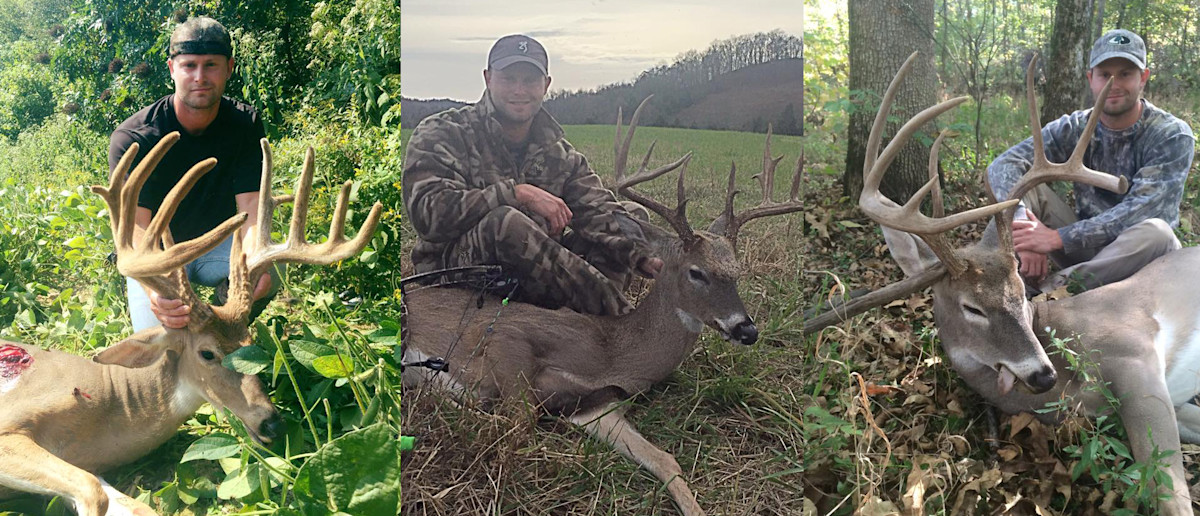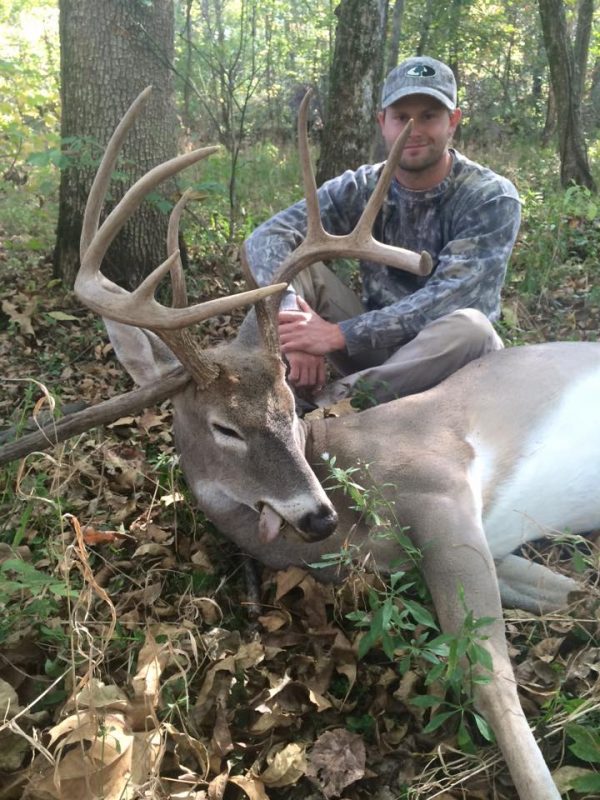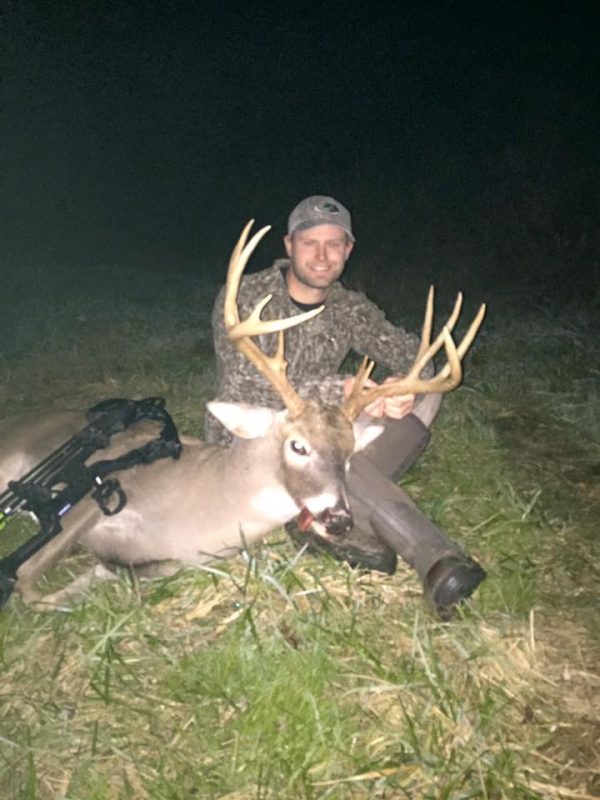
Editor’s note: If you’re new to our DIY Deer Hunter Profile series, here’s the scoop. In each of these pieces, Andy May, a DIY whitetail specialist himself (listen to him on Ep #162 of the podcast), hand picks and interviews the best DIY deer hunters from across the country to help us better understand how they do what they do. After reading today’s profile, be sure to CLICK HERE to see the other hunters Andy has profiled. – MK
By Andy May
Jacob is a deadly DIY hunter that gets it done all over the Midwest. He relies heavily on extensive scouting and preparation and is proof that hard work, dedication and persistence puts big deer on the ground. If you’re hoping to become a better DIY deer hunter, you’re in luck, as Jacob was kind enough to let us dive into his mind and discuss whitetails.
Q: Take me through your hunting journey, how you got started to where you are now:
A: I started hunting when I was about 7 years old behind my parents’ house in AL. We owned about 2 acres back there and I would hunt it with a .410. I shot my first deer, a two year old 9 pt back there and instantly I was hooked. Through my teenage years I hunted in a hunting club in my hometown of Rogersville, AL. This is where hunting became more than a hobby to me. Luckily I had two of my best friends in the club and we spent every waking moment thinking and talking about deer hunting. The name of the game then was killing deer, quality wasn’t as important. A small six or eight point was reason enough to ride around town with the tailgate down. To this day these were some of my best memories. In the eight years we spent there we never cracked the 120” mark on any bucks we killed, but it didn’t matter, as we were killers.
From there I moved on to ground in Southern Tennessee around my senior year of high school. This is where I learned the finer points of hunting. I learned that to kill a big deer you must pass small deer and you also must hunt where they live. I was introduced to guys there that changed the way that I approached hunting. This is the most influential period of time in my hunting career. I soaked up every bit of information that I possibly could from the veteran hunters that I had suddenly found myself around. For 10 years I hung on every word and bit of information that they could provide. I killed some really nice deer during this time including my first couple Pope and Young caliber bucks. However, all good things come to an end and this was no exception. A doctor came in and bought us out, but it wasn’t going to get me down.
The last few years I have been able to put everything together through a combo of trial and error and great teachers. Public land hunting has become a big part of my hunting over the last few years and has made me a better hunter as well. Attention to detail can’t be ignored and this has made my decision making much sharper. I have not found anything as addicting as targeting and killing a mature buck on public land. Along with hunting public land in KY and IL, I also lease ground in MO.
Q: Can you tell me a little bit more about the places that you hunt?
A: The majority of my hunting is done in TN,KY,and IL. Geographically each area presents a little something different. I grew up hunting the cedar thickets and cattle grounds of Southern TN. This area is known more for its abundance of deer rather than quality. Because of the high deer numbers this was a perfect place for me to start learning. As I got older, the draw of hunting outside of the state of TN became greater with the popularity of the sport taking off and growing. My only option to hunt “big deer” states was the public land route as a high school and college student. Shawnee National Forest in Southern IL is the first true out of state area that I concentrated on with its hundreds of thousands of acres of diverse terrain. The southern portion of the state has held its own for many years in the big deer category and just about any piece of public land there is capable of producing a giant. I have been fortunate enough to harvest several Pope and Young deer for the price of a little back work and dedication here. Lastly on the list is Western Ky. No secret here as the western portion of the state has long since been a major producer of big deer. The public land here is similar in geography to the southern portion of IL and is also capable of producing a giant at any time.
Q: You have been really successful on some great looking bucks. Can you dive into a few of your most successful tactics?
A: Early season is all about scouting. If you live in a state where you are fortunate enough to open up early, for instance KY, spend time glassing soybeans. I believe that scouting from a distance this time of year is the best option. As a general rule, I will only step foot in the woods once maybe twice a summer and that’s usually to check a camera that I have on the edge of a preferred food source. It’s important to remember that the deer are predictable, but not stupid this time of year. I have seen bucks completely switch early season patterns because of hunters who simply could not resist the urge to check cameras too often. Early season is one of my favorite times of year to hunt because the bucks are the most visible they will be all season. Take advantage.
When hunting the public lands whether it be during the early season or during the rut don’t be afraid to think outside the box. I have had some of my best encounters with mature deer in and around swamps. I’m not talking about a low area in the woods, but rather a full-fledged mature swamp. I have seen bucks swim in water over their heads to get to small islands in the middle of cyprus swamps. They are here because the hunters aren’t. Pack a climber and some chest waders and sit all day. You would be surprised at the amount of activity that’s going on here that nobody else is willing to get to.
Q: What time of season have you been most successful? Early-season, October, the rut, late season?
A: I have a hard time answering this question. I have by far harvested my best deer during the rut and pre rut periods. However my most prolific success has come in the early season. As of the last four years I have been lucky enough to start my season on the first weekend of September. The deer that I am targeting are in velvet and in bachelor groups, very predictable. My best deer to date came on the opening day of the KY archery season. After scouting him from afar the entire summer and not invading his core area, I was able to harvest him at 6:30PM as he comfortably made his way into a bean field. The rut is certainly king when it comes to the most exciting sits, but I believe the early season in certain states to be a high percentage play.
Q: Where are most of your average guys failing when it comes to success on mature buck?
A: I don’t know that there is one single answer here. I’ll start with this; killing mature bucks, no matter what anyone says, involves a great deal of luck. You can do everything right and still come away empty handed. Sure, there are common mistakes that are made by even veteran hunters though. One thing I see time and time again is a lot of guys are not paying attention to detail. The easiest path into your hunting area is seldom the best route for not alarming deer to your presence. I will often walk the long way around to approach from an area that I know the deer will not. Killing a mature deer involves luck, no doubt, but doing it consistently takes skill, and that means knowing your area. A lot of guys are not putting in the ground work that will tip the odds in their favor.
Q: Can you think back and give me a rough estimate on what percentage of your mature bucks were killed on the first sit in that particular spot?
A: I would probably say 25%. When hunting the early season, if you have a deer patterned I would say you may get two sits there before he knows something is up. When scouting beans in KY I have a lot of confidence with my first sit. At this point of the season I am not making an educated guess, I have done my homework and I know the likelihood of my target buck showing up is very high. I will sit this area only in the afternoons for a couple of days until I have either killed the buck or feel like he is aware he is being hunted. Hunting the rut you can often get away with even going in multiple days in the same stand as long as you are careful. Nothing beats that first time in, and this has been proven time and time again. The element of surprise is often what ends up sealing the deal on mature bucks. Just because you are not there doesn’t mean that your scent isn’t lingering in the area and that’s all it takes to alarm a mature buck.
Q: How would you describe your style of hunting? (Do you have a set system down and stick with it, do you try new and out-of-the-box ideas, are you aggressive, patient?)
A: My system is nothing innovative or different than most I would assume. My first step is to locate several mature bucks, whether it is on public or private land, by running as many cameras on as much property as I possibly can. The goal is to locate these deer and rotate sits around a number of variables. Obviously the wind is the number one factor. If the wind isn’t right, hopefully you have done your homework and have a number of other deer in other areas to hunt. I don’t become obsessed with one particular deer to the point that I stay after him nonstop. If you want to see how quickly you can run a mature deer out of an area, hunt him for a few consecutive days. Keep your areas fresh by staying on the move. Eventually you will put yourself in the path on a deer you have pictures of.
Q: Tell me one or two things that you changed that made a significant impact on your mature buck success.
A: It didn’t start to click for me until I started hunting smarter and not harder. I used to be one of these guys that literally went every chance I could get. I didn’t realize that I was actually hurting myself in the long run. By thinking before acting I have eliminated a lot of errors that I used to never even think about. Also, it’s hard enough to kill a big mature buck but it’s harder if you are pressing to do so. I take this stuff as serious as anyone, but as I stated before, it takes a little luck and it’s important to realize that. Lighten up on yourself. This stuff is supposed to be fun.
Q: Are there any pieces of equipment that you rely on for your style of hunting?
A: Trail cameras and a good climber are two things that I use religiously. As stated before, trail cameras are vital to my success and I will at any time run as many as 50. I like staying mobile and means a good solid climbing tree stand. As we discussed before, the first time in is very important and I want to make sure in many instances that this is not only my first hunt, but the first time I have been in that particular area.
Q: What’s your favorite piece of equipment or one that you would recommend to any hunter under $100?
A: I can’t think of a single more important factor in deer hunting than wind direction; because of this I use Milkweed. This is a cheap way to see not only which direction the wind is blowing but also what your scent is doing once it gets away from your tree. Most have seen the bottled powder that will indicate what the wind is doing, but how about once the powder disappears? The milkweed will flow with the wind and reveal swirling thermals that you never even knew were there. Many times a bluff or hillside will throw your scent the opposite direction 20-30 yards from your immediate location. It’s important to be able to watch exactly what the milkweed does until it hits the ground.







